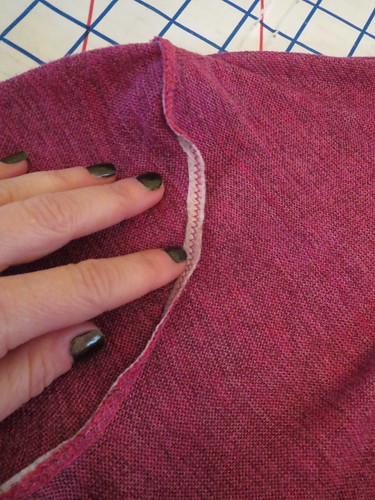
Burda 11-2011-114 has been on my list ever since the magazine was published! I got this fabric at Golden D'Or in Dallas in December 2011 and way overpaid for it at $8.50/yd, but I love the color and the subtle "space dyed" gradation. It is extremely lightweight with little recovery and I don't expect to get more than a dozen wears out of this top before the fabric stretches out beyond redemption. Alas.
The biggest negative for this pattern is that the front piece is a giant fabric hog and I couldn't find an efficient cutting layout that didn't waste a lot of fabric.
The center back is drafted on the fold, which doesn't work for my swayback. I used my TNT tee to shape the side seams and add a center back seam.
This is the "easy" sewing pattern with illustrated instructions for the November 2011 issue. I am sure I would have figured it out eventually from Burda's written instructions, but it was really nice to have the illustrations here.

The back neck finish (which wraps around from the front) is quite clever. You fold the right front's self-facing to the wrong side, then place the right front and left front right sides together. Then you fold the left front's self-facing around the whole back and sew. When you open it up the join is very neat and tidy. In wearing, my top does not have the gathered V-dip at the center back neck shown in the illustration; it just looks like a plain old neckline.
The fabric is very soft and lightweight, one of those fabric where sometimes you can't actually tell if you're touching it or not. Surprisingly, it was not hard to sew. The edges didn't curl or ravel, though it did like to spit out pins.
Because the fabric is so lightweight, I underlined the back only in a tricot. With the front two layers already, a lining would have been too much (and would have interfered with the drape of the neckline).

With the front's cut-on yoke, the shoulder seam is not at the shoulder but several inches below it in the back. Combine that with the dropped armscye, and this lightweight fabric has no support at all on the shoulder. The armscye opening will eventually be at about my knees as the fabric stretches and stretches in wearing.
To try to contain the stretch at the armscye, I fused bias strips of interfacing to the seam allowance (retrofitted after it was sewn). With the dropped shoulder, I'm not sure how much good it will do but maybe it will buy me a few more wears.
The tunic length of this top as drafted was *not* flattering to me, especially in this lightweight fabric that shows every lump and bump. I shortened it 3 inches from the drafted length.

I couldn't tell from Burda's photos whether the neckline would be annoyingly low and require a camisole, but it sits perfectly fine on me--no gapage! I really like the style of this top and the bright color offers some cheer in this neverending winter. Seriously, it snowed on Tuesday. Again.
Though the top will likely be short-lived, the pattern is a keeper. With the dropped shoulder it would make a cute sleeveless summer tee with shoulder coverage, and I'll eventually turn the red merino wool I got from Fabric Mart into another version of the long sleeve top.
All photos are here and the pattern review is here.
